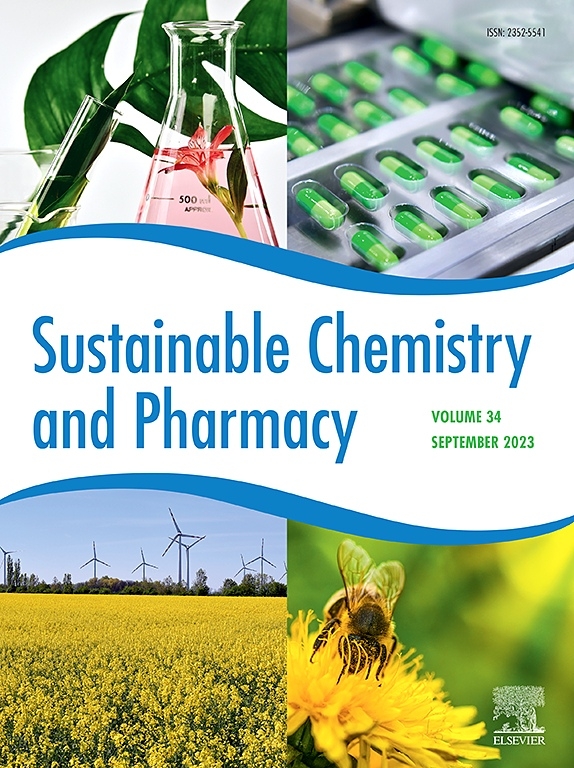Supercritical CO2 extraction of lipids from coffee silverskin: From laboratory optimization to industrial scale-up
IF 5.5
2区 化学
Q2 CHEMISTRY, MULTIDISCIPLINARY
引用次数: 0
Abstract
Coffee is one of the most important food commodities worldwide. During the production of green coffee beans, the outer layers of coffee cherries are discarded generating wastes. Coffee silverskin (CS), the thin tegument covering green coffee beans, is the sole by-product of coffee roasting and is generated in importing countries. CS could be reused in other productive processes due to its interesting chemical composition. In particular, the lipidic fraction of CS presents potentialities in pharmaceutical, packaging, and cosmetic applications. In this work, the supercritical CO2 extraction of lipids from CS has been optimized at lab-scale using response surface methodology, for the first time. Design of experiment (DoE) and Principal Component Analysis were employed to investigate the effect of pressure and temperature on the extraction yield and on the composition of the extract in the range 100–500 bar and 40–80 °C. In particular, the different effect of temperature above and below the crossover pressure has been highlighted.
Based on DoE results, the optimal extraction conditions were set at 400 bar in a temperature range between 50 and 60 °C, applied at industrial scale. As expected, the industrial scale extraction yields resulted higher compared to those obtained in laboratory (3.4 % ± 0.3 and 2.54 % ± 0.06, respectively), while the composition of the extracts did not show significant differences in term of fatty acids. These findings demonstrate the feasibility of scaling up supercritical CO2 extraction of lipids from coffee silverskin, offering a sustainable approach to valorise this by-product for high-value applications in various industries.

咖啡是全球最重要的食品之一。在生产生咖啡豆的过程中,咖啡樱桃的外层会被丢弃,从而产生废物。咖啡银皮(CS)是覆盖在生咖啡豆上的一层薄薄的外皮,是咖啡烘焙的唯一副产品,在进口国产生。由于其有趣的化学成分,咖啡银皮可重新用于其他生产过程。特别是,咖啡渣中的脂质部分在制药、包装和化妆品应用方面具有潜力。在这项工作中,首次使用响应面方法在实验室规模上优化了二氧化碳超临界萃取 CS 脂类的过程。实验设计(DoE)和主成分分析被用来研究在 100-500 巴和 40-80 °C范围内压力和温度对萃取率和萃取物成分的影响。根据 DoE 结果,最佳萃取条件设定为 400 巴,温度范围为 50 至 60 °C,并应用于工业规模。不出所料,工业规模的萃取率高于实验室萃取率(分别为 3.4 % ± 0.3 和 2.54 % ± 0.06),而萃取物的脂肪酸组成没有明显差异。这些研究结果证明了从咖啡银皮中进行超临界二氧化碳萃取脂质的可行性,提供了一种可持续的方法,将这种副产品变废为宝,用于各行各业的高价值应用。
本文章由计算机程序翻译,如有差异,请以英文原文为准。
求助全文
约1分钟内获得全文
求助全文
来源期刊

Sustainable Chemistry and Pharmacy
Environmental Science-Pollution
CiteScore
8.20
自引率
6.70%
发文量
274
审稿时长
37 days
期刊介绍:
Sustainable Chemistry and Pharmacy publishes research that is related to chemistry, pharmacy and sustainability science in a forward oriented manner. It provides a unique forum for the publication of innovative research on the intersection and overlap of chemistry and pharmacy on the one hand and sustainability on the other hand. This includes contributions related to increasing sustainability of chemistry and pharmaceutical science and industries itself as well as their products in relation to the contribution of these to sustainability itself. As an interdisciplinary and transdisciplinary journal it addresses all sustainability related issues along the life cycle of chemical and pharmaceutical products form resource related topics until the end of life of products. This includes not only natural science based approaches and issues but also from humanities, social science and economics as far as they are dealing with sustainability related to chemistry and pharmacy. Sustainable Chemistry and Pharmacy aims at bridging between disciplines as well as developing and developed countries.
 求助内容:
求助内容: 应助结果提醒方式:
应助结果提醒方式:


